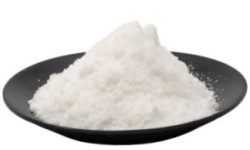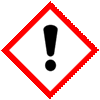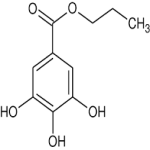CAS Number 121-79-9, Propyl Gallate USP NF BP Ph Eur FCC Food Grade Manufacturers Exporters







CAS Number 121-79-9, Propyl Gallate Manufacturer Exporter
For Properties Specifications of Propyl Gallate Click Properties, Specifications of Propyl Gallate Manufacturer.
For Uses of Propyl Gallate Click Uses of Propyl Gallate Manufacturer.
For For SDS MSDS Sheet of Propyl Gallate Click SDS Safety Data Sheet MSDS Sheet of Propyl Gallate Manufacturer.
The Properties and Specifications of Propyl Gallate:
Propyl Gallate USP Grade Specifications
C10H12O5 --- 212.20 --- CAS 121-79-9
Benzoic acid, 3,4,5-trihydroxy-, propyl ester.
Propyl Gallate contains not less than 98.0 percent and not more than 102.0 percent of C10H12O5, calculated on the dried basis.
Identification:
A: Infrared Absorption 197M .
B: Ultraviolet Absorption 197U
Solution: 10 3g per mL.
Medium: methanol.
Melting range: between 146 and 150 .
Loss on drying: Dry it at 105 for 4 hours: it loses not more than 0.5% of its weight.
Residue on ignition: not more than 0.1%.
Heavy metals: 0.001%.
Propyl Gallate BP Ph Eur Grade Specifications
Ph Eur --- C10H12O5 --- 212.2 --- CAS 121-79-9
Action and use: Antioxidant.
DEFINITION
Propyl gallate contains not less than 97.0 per cent and not more than the equivalent of 103.0 per cent of propyl 3,4,5-trihydroxybenzoate, calculated with reference to the dried substance.
CHARACTERS
A white or almost white, crystalline powder, very slightly soluble in water, freely soluble in ethanol (96 per cent). It dissolves in dilute solutions of alkali hydroxides.
IDENTIFICATION
First identificationiB.
Second identificationiA, C, D.
A. Melting point: 148C to 151C.
B. Examine by infrared absorption spectrophotometry.
C. Examine the chromatograms obtained in the test for gallic acid.
D. Dissolve about 10 mg in 10 ml of water by heating to about 70C. Cool and add 1 ml of bismuth subnitrate solution. A bright yellow precipitate is formed.
TESTS
Appearance of solution: Dissolve 1.0 g in ethanol (96 per cent) and dilute to 20 ml with the same solvent. The solution is clear and not more intensely coloured than reference solution.
Gallic acid: Examine by thin-layer chromatography.
Total chlorine: Mix 0.5 g with 2 g of calcium carbonate. Dry and ignite at 700 ± 50C. Take up the residue with 20 ml of dilute nitric acid and dilute to 30 ml with water. 15 ml of the solution, without further addition of dilute nitric acid, complies with the limit test for chlorides (200 ppm).
Chlorides: To 1.65 g add 50 ml of water. Shake for 5 min. Filter. 15 ml of the filtrate complies with the limit test for chlorides (100 ppm).
Zinc: Not more than 25.0 ppm of Zn, determined by atomic absorption spectrometry
Heavy metals: 2.0 g complies with limit test C for heavy metals (10 ppm). Prepare the reference solution using 2 ml of lead standard solution (10 ppm Pb).
Loss on drying: Not more than 0.5 per cent, determined on 1.000 g by drying in an oven at 105C.
Sulphated ash: Not more than 0.1 per cent, determined on 1.0 g.
Propyl Gallate FCC Food Grade Specifications
Gallic Acid, Propyl Ester
C10H12O5 Formula weight 212.20
INS: 310 CAS 121-79-9
DESCRIPTION
Propyl Gallate occurs as a fine, white to nearly white powder. It is slightly soluble in water and freely soluble in alcohol and in ether.
Function: Antioxidant.
REQUIREMENTS
Identification: Place about 5 g of sample and several boiling chips into a 500-mL round-bottom flask, connect a water-cooled condenser to the flask, and introduce a steady stream of nitrogen into the flask, maintaining the flow of nitrogen at all times during the remainder of the procedure. Pour 100 mL of 1 N sodium hydroxide through the top of the condenser, heat the solution to boiling, boil for 30 min, and cool. Place the round-bottom flask in an ice bath, and slowly, with occasional swirling, add dilute sulfuric acid (10%) until a pH of 2 to 3 is obtained (using pH paper). Filter the precipitate through a sintered-glass crucible, wash with a minimum amount of water, and dry at 110C for 2 h. The gallic acid so obtained melts at about 240C with decomposition.
Assay: Not less than 98.0% and not more than 102.0% of C10H12O5 after drying.
Lead: Not more than 1 mg/kg.
Loss on Drying: Not more than 0.5%.
Melting Range: Between 146C and 150C.
Residue on Ignition: Not more than 0.1%.
The Uses of Propyl Gallate:
Propyl Gallate is used as an antioxidant in cosmetic products at maximum concentrations of 0.1%. Propyl Gallate is a generally recognized as safe (GRAS) antioxidant to protect fats, oils, and fat-containing food from rancidity that results from the formation of peroxides. Propyl gallate is used to protect oils and fats in products from oxidation. It is used in foods, cosmetics, hair products, adhesives, and lubricants. It is used as an antioxidant for foods and cosmetics. It is a widely used antioxidant in pharmaceutical formulations like emulsions,
The MSDS-SDS Hazard Statement of Propyl Gallate:
Propyl Gallate SDS Safety Data Sheet
MSDS Sheet, Material Safety Data Sheet 18-Jan-23
1. Product Identification
Product Name & Other Names: Propyl Gallate or Propyl 3,4,5-trihydroxybenzoate.
CAS No.: 121-79-9
EINECS EC Number: 204-498-2
Molecular Weight: 212.20
Chemical Formula: C10H12O5
Relevant uses and uses advised against (if any): Industrial Manufacturing.
2. Hazards Identification
GHS, Globally Harmonized System Classification in accordance with 29 CFR 1910
Classification according to Regulation (EC) No 1272/2008
Acute toxicity, Oral (Category 4), H302
Skin sensitization (Category 1), H317
Labeling according to GHS & Regulation (EC) No 1272/2008
GHS Label Elements  Irritant |
Signal Words: Warning
Hazard statements:
H302: Harmful if swallowed.
H317: May cause an allergic skin reaction.
Precautionary statements:
P261: Avoid breathing dust/fume/gas/mist/vapors/spray.
P270: Do not eat, drink or smoke when using this product.
P272: Contaminated work clothing should not be allowed out of the workplace.
P280: Wear protective gloves/protective clothing/eye protection/face protection.
P301+312: IF SWALLOWED: Call a POISON CENTER or doctor/physician if you feel unwell.
P302+352: IF ON SKIN: Wash with soap and water.
P333+313: If skin irritation or a rash occurs: Get medical advice/attention.
P305+351+338: IF IN EYES: Rinse cautiously with water for several minutes. Remove contact lenses if present and easy to do – continue rinsing.
3. Composition/Information on Ingredients
Product Name & Other Names: Propyl Gallate or Propyl 3,4,5-trihydroxybenzoate.
CAS No.: 121-79-9
EINECS EC Number: 204-498-2
4. First Aid Measures
Always seek medical attention after first aid measures are provided.
Inhalation: If inhaled, remove to fresh air. If not breathing, give artificial respiration. If breathing is difficult, give oxygen and get medical attention immediately.
Ingestion: Induce vomiting immediately as directed by medical personnel. Never give anything by mouth to an unconscious person. Get medical attention.
Skin Contact: Immediately flush skin with plenty of water for at least 15 minutes while removing contaminated clothing and shoes. Get medical attention. Wash clothing and shoes before reuse.
Eye Contact: Immediately flush eyes with plenty of water for at least 15 minutes, lifting lower and upper eyelids occasionally. Get medical attention immediately.
5. Fire Fighting Measures
Fire: As with most organic solids, fire is possible at elevated temperatures or by contact with an ignition source.
Explosion: Fine dust dispersed in air in sufficient concentrations, and in the presence of an ignition source is a potential dust explosion hazard.
Fire Extinguishing Media: Water spray, dry chemical, alcohol foam, or carbon dioxide.
Special Information: In the event of a fire, wear full protective clothing and NIOSH-approved self-contained breathing apparatus with full face piece operated in the pressure demand or other positive pressure mode. At high temperatures under fire conditions, it may produce toxic or irritating fumes. Fire-extinguishing work is done from the windward and the suitable fire-extinguishing method according to the surrounding situation is used.
6. Accidental Release Measures
Personal precautions, protective equipment, and emergency procedures: Avoid breathing dust/fumes/gas/mist/vapors/spray. Use individual protective equipment (waterproof boots, suitable protective clothing, safety glasses, etc.). Do not approach facing the wind.
Environmental precautions: Do not let the product enter drains, soil or water sources.
Methods and materials used for containment Cleanup procedures and Storage: Harmful solid. Stop leak if without risk. Do not get water inside container. Do not touch spilled material. Use water spray to reduce vapors. Prevent entry into sewers, basements, or confined areas; dike if needed. Eliminate all ignition sources.
7. Handling and Storage
Precautions for safe handling: Apply according to good manufacturing and industrial hygiene practices. Ensure proper ventilation. Wash thoroughly after handling. Do not drink, eat, or smoke while handling. Avoid contact with skin, eyes, and clothing. Minimize dust generation. Avoid breathing dust/fumes/gas/mist/vapors/spray. Avoid contact with eyes, skin, and clothing. Keep container tightly closed. Avoid ingestion and inhalation. Use individual protective equipment (waterproof boots, suitable protective clothing, safety glasses, etc.).
Conditions for safe storage, including any incompatibilities: Store in cool, dry, and ventilated area away from heat sources and protected from sunlight in tightly closed original container. Keep air contact to a minimum. Do not leave the material container open. Store protected from heat, sparks and ignition sources and incompatible materials. Avoid contact with skin and eyes. Avoid inhalation of dust/mist/vapor. Do not store with incompatible materials like strong oxidizers, strong acids, strong bases, strong reducing agents. Containers may be hazardous when empty since they retain product residues. Avoid dust formation and control ignition sources. Employ grounding, venting and explosion relief provisions in accord with accepted engineering practices in any process capable of generating dust and/or static electricity. Empty only into inert or non-flammable atmosphere.
8. Exposure Controls/Personal Protection
Airborne Exposure Limits: None established.
Ventilation System: A system of local and/or general exhaust is recommended to keep employee exposures as low as possible.
Personal Respirators (NIOSH Approved): For conditions of use where exposure to dust or mist is apparent and engineering controls are not feasible, a particulate respirator (NIOSH type N95 or better filters) may be worn.
Skin Protection: Wear impervious protective clothing, including boots, gloves, lab coat, apron or coveralls, as appropriate, to prevent skin contact.
Eye Protection: Use chemical safety goggles and/or full face shield where dusting or splashing of solutions is possible. Maintain eye wash fountain and quick-drench facilities in work area.
Other Control Measures: Maintain good housekeeping in work area. Handle in accordance with good industrial hygiene and safety practice.
9. Physical and Chemical Properties
Appearance: White to beige powder or crystals.
Odor: Not available.
Odor threshold: Not available.
pH: < 5.5 to 7.
Relative density: 1.21
Boiling Point: Decomposes.
Melting Point: 146 - 150C
Flash point: Not available.
Auto-ignition temperature: Not available.
Decomposition temperature: Not available.
Upper/lower flammability or explosive limits: Not available.
Vapor pressure: Not available.
Vapor density: Not available.
Evaporation rate: Not available.
Flammability (solid, gas): Not available.
Partition coefficient: n-octanol/water: Not available.
Solubility: Soluble in water.
Viscosity: Not available.
10. Stability and Reactivity
Stability: Stable under ordinary conditions of use and storage.
Hazardous Decomposition Products: Carbon dioxide and carbon monoxide may form when heated to decomposition.
Hazardous Polymerization: Will not occur.
Incompatibilities: Strong oxidizers, strong acids, strong bases, strong reducing agents.
Conditions to Avoid: Heat, dusting and incompatibles.
11. Toxicological Information
Oral rat LD50: 2,100 mg/Kg
Carcinogenicity: No component of this product present at levels greater than or equal to 0.1% is identified as possible or confirmed human carcinogen by IARC, ACGIH, OSHA and NTP.
Teratogenic Effects: Not available.
Mutagenic Effects: Investigated as a drug, mutagen, reproductive effector, and tumorigenic.
Developmental Toxicity: Not available.
Reproductive Effects: Investigated as a drug, mutagen, reproductive effector, and tumorigenic.
12. Ecological Information
Environmental Fate: When released into the soil, it is expected to leach into groundwater. When released into the soil, this material is expected to readily biodegrade. When released into water, this material is expected to readily biodegrade.
Persistence and Degradability: Unlikely to persist due to its water solubility.
Mobility: Will likely be mobile in the environment due to its water solubility.
Bioaccumulation/ Accumulation: No information available.
Results of PBT and vPvB assessment: No data available for assessment.
13. Disposal Considerations
Whatever cannot be saved for recovery or recycling should be managed in an appropriate and approved waste disposal facility.
14. Transport Information
DOT USA, TDG Canada & ADR/RID Europe: Not controlled.
IMDG/IMO: Not controlled.
IATA: Not controlled.
15. Regulatory Information
USA:
SARA 311/312: See section 2.
California Prop. 65 Components: Not listed.
16. Other Information
Disclaimer:
**************************
Our company provides this MSDS sheet in good faith but makes no representation as to its comprehensiveness or accuracy. This SDS sheet is intended only as a guide to the appropriate precautionary handling of the material by a properly trained person using this product. The above information has been compiled from various sources and has the possibility of discrepancy and being out-dated information. Individuals receiving the information must exercise their independent judgment and do further search in determining its appropriateness for a particular purpose. In no case shall our company be liable to loss or damages by the product user.
**************************
Anmol Chemicals & Pharmaceuticals Pvt. Ltd. is an off-shoot of Anmol Chemicals Taloja. It is located in MIDC Taloja and it is manufacturing pharmaceutical grades of API, Excepients, Food grade and Reagent grade chemicals. Anmol Chemicals & Pharmaceuticals Pvt. Ltd. is a several decades old group of companies, engaged in manufacturing, supplying, distributing, wholesale supplies for actual users, retail or small pack supplies for research and development chemicals, fine and speciality chemicals, pharmaceutical excipients, mineral fortifiers in chemically pure, Analytical reagent grade, IP BP USP Ph Eur EP JP and other pharmaceutical grade monograph including FCC Food grade chemicals and Nutraceuticals, Mineral Fortifiers at best prices.

Propyl Gallate Structure
CAS Number 121-79-9, Propyl Gallate Manufacturer Exporter
ANMOL CHEMICALS & PHARMACEUTICALS Pvt. Ltd.
India, USA, Europe, UAE
TELEPHONE: +912223770100
Navi Mumbai, INDIA
e-mail: info(At the rate i.e. @)anmol.org
Copyright. 24-nov-24
We manufacture:
Glacial Acetic Acid Manufacturer

